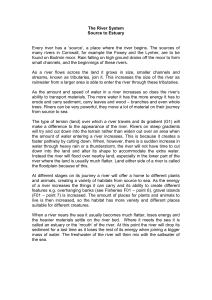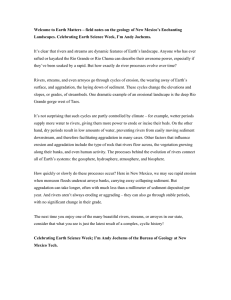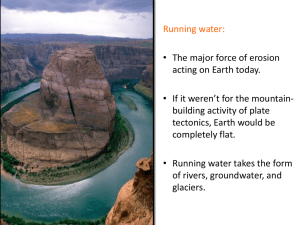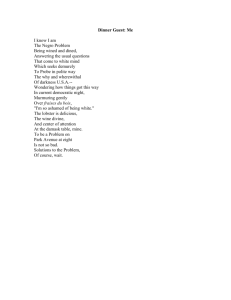GY 111 Lecture Note Series Sedimentary Environments 2: Rivers and Deltas
advertisement
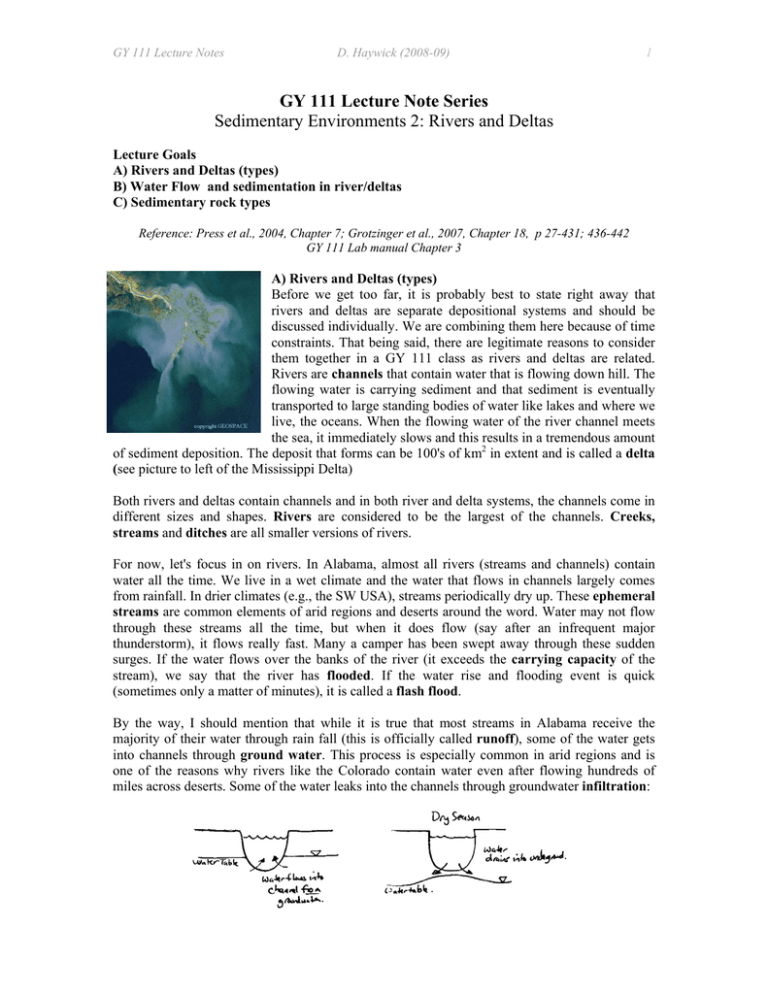
GY 111 Lecture Notes D. Haywick (2008-09) 1 GY 111 Lecture Note Series Sedimentary Environments 2: Rivers and Deltas Lecture Goals A) Rivers and Deltas (types) B) Water Flow and sedimentation in river/deltas C) Sedimentary rock types Reference: Press et al., 2004, Chapter 7; Grotzinger et al., 2007, Chapter 18, p 27-431; 436-442 GY 111 Lab manual Chapter 3 A) Rivers and Deltas (types) Before we get too far, it is probably best to state right away that rivers and deltas are separate depositional systems and should be discussed individually. We are combining them here because of time constraints. That being said, there are legitimate reasons to consider them together in a GY 111 class as rivers and deltas are related. Rivers are channels that contain water that is flowing down hill. The flowing water is carrying sediment and that sediment is eventually transported to large standing bodies of water like lakes and where we live, the oceans. When the flowing water of the river channel meets the sea, it immediately slows and this results in a tremendous amount of sediment deposition. The deposit that forms can be 100's of km2 in extent and is called a delta (see picture to left of the Mississippi Delta) Both rivers and deltas contain channels and in both river and delta systems, the channels come in different sizes and shapes. Rivers are considered to be the largest of the channels. Creeks, streams and ditches are all smaller versions of rivers. For now, let's focus in on rivers. In Alabama, almost all rivers (streams and channels) contain water all the time. We live in a wet climate and the water that flows in channels largely comes from rainfall. In drier climates (e.g., the SW USA), streams periodically dry up. These ephemeral streams are common elements of arid regions and deserts around the word. Water may not flow through these streams all the time, but when it does flow (say after an infrequent major thunderstorm), it flows really fast. Many a camper has been swept away through these sudden surges. If the water flows over the banks of the river (it exceeds the carrying capacity of the stream), we say that the river has flooded. If the water rise and flooding event is quick (sometimes only a matter of minutes), it is called a flash flood. By the way, I should mention that while it is true that most streams in Alabama receive the majority of their water through rain fall (this is officially called runoff), some of the water gets into channels through ground water. This process is especially common in arid regions and is one of the reasons why rivers like the Colorado contain water even after flowing hundreds of miles across deserts. Some of the water leaks into the channels through groundwater infiltration: GY 111 Lecture Notes D. Haywick (2008-09) 2 There are many types of rivers, but the two most common are 1) meandering (as pictured to the left) and 2) braided (pictured to the right). The two form in response to different slopes. Meandering rivers form in areas of shallow slope; braided rivers form on steeper slopes. The term “slope” really is meaningless when applied to rivers. It is better to use the term gradient which is defined as: vertical drop (feet) horizontal distance (mile) The gradient is reported as a number and the units are retained. A “steep” gradient might be 300 to 1200 ft/mile, whereas a “shallow” gradient might only be 50 or 60 ft/mile. Rivers are capable of flowing down very shallow gradients (only a few feet per mile), but the way they flow is not consistent. On steep gradients, the water flows in an almost straight line. Sometimes the channel is straight, but more often than not, it forms a braided pattern with numerous sand/gravel bars breaking up the flow. Thus is born a classic braided stream. If the gradient is very shallow, the stream forms a classic meandering pattern. Channels in deltas are almost always meandering because the gradient at sea level where deltas form is so low; however, like rivers, deltas do come in different "flavors". We recognize 3 distinct varieties based upon major morphological characteristics and the dominant depositional process at the site of deposition: 1) Bird's Foot (e.g., Mississippi Delta) -form where waves and tides are weak 2) Wave-dominated (e.g., Nile Delta) -form where waves are strong 3) Tide-dominated (e.g., Ganges River Delta) -form where tides are extreme GY 111 Lecture Notes D. Haywick (2008-09) 3 We are talking about depositional environments so you are correct in suspecting that sediment is deposited in both river and delta environments. Sediment is actually deposited in two different components of rivers/deltas, (1) the channel and (2) the flood plain. We'll tackle each of these in the next section of this lecture but I have to warn you that some of the explanation requires an understanding of water flow. The study of water flow is one of the subject areas of hydrodynamics which can, at times, require differential equations and statistics. Luckily for use, this is not one of those times. B) Water flow in meandering channels The cartoon below is a cross section of a meandering channel. It could be across a river channel or a delta channel. The process of water flow is the same regardless of the depositional environment in question. Note that in the cartoon, the channel is not symmetrical. The banks of the channel have a steep side (the cutbank side) and a shallow side (the point bar) This asymmetry generates a prominent "corkscrew" motion to the water flowing in the channels. In other words, water spirals across the channel as the water flows down stream. Why is this important? The corkscrewing motion circulates water from the deep part of the channel just adjacent to the cutbank to the shallow part of the channel adjacent to the point bar. The deepest part of the channel is where the water flows the fastest and the shallowest part of the channel is where it flows the slowest. So the corkscrewing motion has the effect of moving water from the fast part of the current to the slow part. Now as we have discussed previously, flowing water is capable of transporting sediment. The faster the water flow, the coarser the sediment that is transported. It stands to reason therefore, that if the water in a meandering channel corkscrews from fast flow to slow flow, the coarsest sediment it erodes when moving fast (deep channel) is quickly dropped (deposited) when the current slows in the shallowest part of the channel. To make a long story short, sediment is eroded from the cutbank side of the channel and sand is deposited on the point bar side of the channel. This is in fact the reason that meandering channels meander. The coarsest material of all is eroded from the cutbank and dropped immediately to the base of the channel. This so called channel lag is quickly buried as the point bar migrates toward the cutbank. GY 111 Lecture Notes D. Haywick (2008-09) 4 Deposition that takes place on the flood plain occurs through a completely different mechanism than what happens in the channels and only occurs when the channel enters flood stage (see image to left). As mentioned earlier, flooding occurs when more water enters the channels than can be carried by the channel. Once the carrying capacity is exceeded, water spills over onto the floodplain. The water moving in the channel is flowing at a very rapid velocity, and when it spills onto the floodplain, it slows very quickly. The coarsest sediment (fine sand) is dropped right along the flanks of the channel and eventually forms natural levees, but the finest sediment (silt and clay) is carry much further away from the channel. In the greatest floods, the entire floodplain can be covered in water which will eventually lead to a thin layer of mud as the floodwater evaporate. The mud deposited on river floodplains is almost always red for the same reasons provided during the lecture on alluvial fans; however, delta flood plain sedimentation is different. It is deposited in an environment rich in plants and water. Instead of drying out, the mud often stays wet and the depositional environment goes anaerobic instead of aerobic. The lack of oxygen in the "swampy" conditions of a delta floodplain may convert any Fe3+ in the sediment into Fe2+ making the mud greenish-grey in color. If there is a lot of carbon in the sediment (which is typical for deltas), the mud may actually go black. Delta floodplain can frequently distinguished from their river counterparts in the rock record on the basis of shale colour. C) Sedimentary rocks deposited in rivers and deltas There are a wide variety of rock types that are deposited in river environments depending upon where in the river system you are (i.e., close to the sediment source in the mountains or close to the shoreline). Braided streams and channel lags in meandering rivers are typically coarse grained (gravel) that is well rounded. The sedimentary rocks are called conglomerates and if you see one in the lab, you can be assured that it is the product of river channel deposition. Point bars are more typically composed of sandstone, usually lithic sandstone or nearer to the coast line, quartz arenite. In both cases however, point bar sandstone is usually less "clean" than the sand you see deposited on beaches (see the next lecture for more on beaches). River floodplain deposited sedimentary rocks are as previously mentioned, red shales. They are generally easy to distinguish from the red shales deposited on alluvial fans because the contain GY 111 Lecture Notes D. Haywick (2008-09) 5 more evidence of plants and animals (particularly plant roots and bones). These fossils are commonly preserved in ancient river flood plains many millions of years old. Delta point bar deposited sedimentary rocks closely resemble their river counterparts. They are usually lithic sandstone and quartz arenite. Conglomerate is very rare to non existent in delta channels. The floodplain deposited sedimentary rocks are green or black shales and commonly contain abundant evidence of plants (including sporadic coal beds) and marine fossils like crabs and shells. The "holes" that the marine beasties lived in (burrows) are also commonly preserved in the green/black shale indicating marine influenced deposition. Important terms/concepts from today’s lecture (Google any terms that you are not familiar with) Rivers, streams, creeks channels deltas ephemeral rivers carrying capacity flooding, flood stage infiltration meandering, braided rivers bird's foot, wave-dominated, tide-dominated rivers flood plain cutbank, point bar channel lag conglomerate lithic sandstone quartz arenite red shale green shale black shale natural levees

